How to clean the drum in the washing machine: sequence of steps
The washing machine, along with any other types of household appliances, needs competent care. As a result of operation, fat settles on the drum of the unit and other working bodies, mineral deposits and persistent pollution appear.
They will certainly lead to an increase in load and to subsequent damage. Regular cleaning of the drum in the washing machine will significantly increase the life of the equipment. Let's figure out how to properly clean the drum.
The content of the article:
Regular cleaning - great prevention
The washing machine is without the slightest doubt attributed to the obligatory components of the equipped housing. It is hard to imagine that someone could do without this “tireless home helper” now. Diligently dealing with our problems, the machine interacts with detergents, technical and edible oils, poorly filtered tap water.
In terms of sedimentation, the most vulnerable component of the unit is the drum, which is in direct contact with both laundered laundry and powders, conditioners and similar liquid agents. Unfortunately, most housewives judge drum pollution only by odorresembling the "aromas" of the swamp.
In fact, the smell is not the most insidious enemy of washing equipment, although it should be given extreme attention. It signals the appearance of putrefactive bacteria and mold fungithat are harmful to the things being processed by the machine, and not to the working units and parts.
Note that the atmosphere formed by microorganisms creates an extremely serious threat to the health of owners of premises with a washing machine. So, it should be fought with zeal worthy of its significance.
The danger to the functional parts of washing units lies in mineral plaque. This scale settles both on the surface of the drum accessible to users and on its back side. If the first component can easily be cured by folk remedies, then to eliminate the second one it is often required machine disassembly with removing the drum tank.
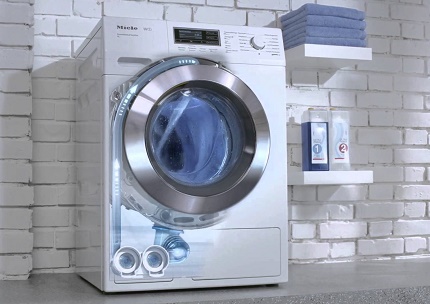
The list of problems created by scale includes:
- Violation of water circulation during washing. Clogged sediment perforation of the drum prevents the normal flow and outflow of water.
- Defective drain pump. By “squeezing” water through a filter clogged with scale, the pump experiences almost cosmic loads, eventually breaking.
- Slowing down water heating. Mineral sediment has significantly lower thermal conductivity than metal parts of a machine without it. Mineral deposits as a result affect the quality of the wash.
- Increased energy consumption. Units and systems operating in load mode consume more electricity.
- Accelerated wear on the tank and drum pulley. Mineral sediment contributes to the abrasion of contacting and closely spaced elements.
The scum appears due to the supply of water to the machine with an impressive content of magnesium and calcium salts. Eliminate or significantly reduce the intake will help the installation of trunk filters. However, they will not be able to completely eliminate the likelihood of sediment formation. Those. you still have to clean the unit, though much less often.

Of course, rust also applies to factors dangerous for washing machines, but the main part of the body suffers from it. Drums are made of materials adapted to work in water with household chemicals. Although this does not mean at all that they are not susceptible to rust in cheap units.
In order to exclude all possible prerequisites for reducing the life of the machine and conditions that threaten the health of the owners, regular, well-made care is necessary. With the features of its implementation should be sorted out.
Washing drum care methods
We have already found out that it is the scum that causes the most damage to the drum, and bacteria with fungi are the user's health. It is clear that microorganisms need disinfectants to declare war, and substances capable of dissolving it are required to remove mineral deposits.

The principle of cleaning the drum in both situations is to process its surface, for which machine owners have two methods at their disposal, these are:
- Using the cleaning mode. It is possible to use only in units with the specified function, for example, in equipment of the LG brand with the ECO cleaning mode.
- Application and flushing of the composition with the corresponding problem action. It is used in automatic and semi-automatic machines without the above function.
Both methods involve a kind of “washing”, but without loading the laundry. In the first case, the equipment corny "rinses" the drum and other components with hot water, in the second case, the unit is switched on for the banal washing off of the substance previously applied to the drum.
Using Auto Clean
Happy owners of machines with a drum cleaning mode do not need to spend personal time on, frankly, difficult care. Their equipment is independently freed from greasy deposits, detergent residues, grains of sand and fine organic matter. Everything that the unit could not handle during the washing period is dissolved and removed.
Cleaning is carried out in three standard steps:
- Normal preview mode is activated.
- The cleaning function is activated at 90 ° C and at a speed of 150 rpm. There are washing machines on the market that perform similar work at 50-60 ° C.
- A double spin rinse is started, spinning at maximum speed.
Before washing the washing drum clean filterso that nothing interferes with the discharge of water. Note that the described procedure does not eliminate mineral plaque. In order to get rid of scale, a bag of “Anti-scale” or citric acid is poured into the receiving cuvette of the machine before starting.
At the end of the program, the hatch should open or at least open at an angle that does not impede the free movement of the bathroom or kitchen. The moisture remaining in the drum should completely evaporate, after which it should be wiped with a dry, “non-dusting” rag, i.e. not leaving fibers on the surface.
It should be remembered that a double rinse is simply obliged to completely remove from the tank all the product and the scum dissolved by it. If there is a suspicion that the substance used in cleaning is not all washed off with water, the process should be repeated. Otherwise, during normal washing, the linen will fade, fade, and after that it will wear out faster.
The described very useful mode, unfortunately, is not available for all washing units. If the owners of the equipment failed to buy such a machine, the actions are performed in a different order.
The use of folk techniques
Let's start with the intimidation and enumeration of the horrors that threaten the use of excessively active agents to clean the drum.
The results of the use of unjustifiably corrosive substances include:
- Softening and spoilage of sealants. In particular, deformation of the rubber cuff of the laundry loading hatch requiring immediate replacements.
- Damage to the metal surface of the drum. The appearance of roughness and even burrs will cause loss of appearance of clothing.
- Changing the shape and size of plastic parts, as a result, the formation of backlash, weakening of joints.
- Jamming of the moving elements of the machine due to falling into the gap between them a large piece of undissolved scale.
- Clogged drain filter and subsequent pump failure.
In addition, if the strongly acting chemistry is not completely removed from the surfaces of the drum, it will fall into the water when washing. Absorbing caustic substances underwear will cause allergies, it is possible that a chemical burn.
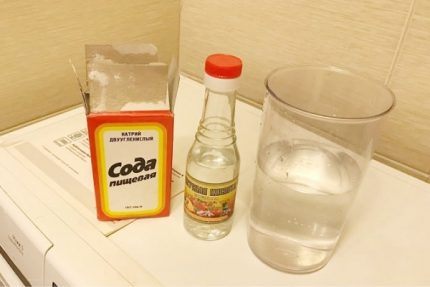
Given the above circumstances, the use of "folk recipes", especially their dosage, should be treated with utmost care.
We remember that to remove mineral sediment we need to dissolve it or at least soften it. This is easy to do without a master, without disassembling the unit into its component parts and without removing the drum to the outside. To do this, from completely accessible and really inexpensive ingredients, you will have to prepare a composition that corrodes the sediment, but does not affect the working bodies of the unit.
Any housewife will be able to find the source material for the cleaning mixture in her own adored kitchen. To combat magnesium and calcium salts, you will need only ordinary table vinegar, just as outstanding as citric acid and soda. They are perfect and cost just a penny.
Method number 1 - soda with vinegar against scale
For mixing in the required proportions, we stock up with a plastic cup with a volume of 50 - 100 g, and a sponge. If the house does not already have nine percent vinegar ready, it must be done by dissolving one part of the essence in seven parts of water.
To clean the drum, we will act in the following order:
- We measure out 1/4 of a plastic cup of baking soda and exactly the same volume of water, mix them until the powder is completely dissolved.
- Pour this cool soda solution into the box of the machine, designed to load detergents.
- We take 2 portions of nine percent vinegar marked with a glass and pour them into the drum.
We close the hatch as expected, open the tap, which blocks the flow of water into the supply hose from the water supply. On the control panel, set the temperature to 60 - 70 ° C, start the “wash” session. Upon completion of cleaning, we clean the drain system filter, leave the unit with the sunroof open for drying, then wipe it dry.
Method No. 2 - Citric Acid
The following method is much simpler. For him, in general, only citric acid is needed, the volume of which is selected according to the volume of the tank of the machine. It will take from 1 to 6 standard packs.
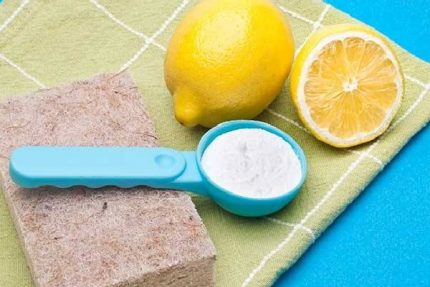
To clean the drum machine do the following:
- Dilute the powdered lemon with water in equal proportions.
- Pour the solution into the detergent box.
- Run the longest washing mode.
At the time of cleaning, the indicated method must select the maximum temperature. Further actions are no different from the steps described above.
Detailed instructions for cleaning the washing machine with citric acid can be found in this stuff.
Method No. 3 - Soda Powder Cleaning
You will need a sponge with a hard lining on one side and a pack of soda, its actual consumption is determined during cleaning. A solution of soda does not need to be prepared.
In the case of cleaning the drum, we perform the following steps:
- Pour baking soda onto the hard pad of the sponge and carefully wipe away any dirt.
- As soda is consumed, add it to the sponge. In case of a weak reaction of soda and scale, slightly moisten the sponge.
- We leave the drum in complete rest for half an hour, until the calcium growths soften.
- We activate the wash by setting the temperature to 70 - 90 ° С.
- We set the double rinse mode on the control panel.
If, at the end of the rinse, you feel that the drum is poorly washed with soda, the machine will have to start again. However, it will be necessary to withstand the time interval specified by the manufacturer between the two washing sessions occurring one after another.
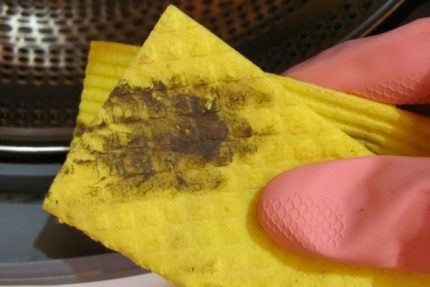
In addition to folk wisdom and its proposed compositions, household cleaning products that are purposefully released to solve the indicated problems are used in the cleaning work.
On the packaging with the product, a detailed briefing on its use and dosage recommendations are traditionally given.
Valuable tips on car care
Do not get involved in tough measures in caring for a washing machine drum, it is better not to bring the equipment to such a sad state.
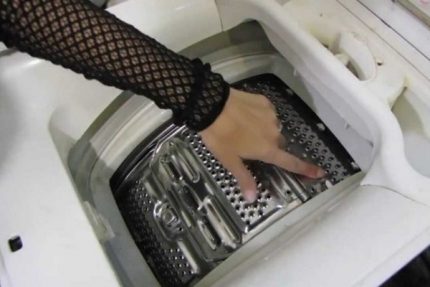
To prevent the formation of mineral deposits on the walls of the drum:
- Use anti-scale for washing machines. In the data sheets of automatic and semi-automatic devices, the frequency of use of preparations of the Calgon type is indicated. It depends on the formula of plastic and elastomers of specific models.
- Install softener filter. The inclusion of filtering mechanical and magnetic devices in the water supply system will eliminate the entry of hard water into the tank of the machine.
- Wash primarily at 40 - 50 ° C. In the process of high-temperature washing, scale is formed much more intensively than at low temperatures.
- Check the pockets of things loaded into the unit. Before washing, carefully check the contents of the pockets so that objects that pose a risk of clogging do not get inside.
- “Ventilate” the tank regularly.It is necessary to allow the details of the washing machine to dry.
- Avoid cleaning the unit with a direct stream of water. Prevent even droplets from falling onto the electronic control system.
- Regularly care for the machine. Regular maintenance is required to extend the life of the unit.Manual steps are only required when disconnected from the power supply.
You also do not need to pour more powder into the box than is required to produce one wash. To combat unpleasant odor, the use of chlorine-containing varieties of household chemicals is permissible.
Conclusions and useful video on the topic
Care and prevention of washing machines with a drum cleaning function:
Citric acid in the care of technology:
User advice on the prevention and cleaning of the washing machine:
Compliance with the simple rules of operation of the washer, prevention and the reasonable use of cleaning products are a guarantee of service lives that exceed the limits declared by the manufacturer.
How do you clean the drum in your washer? Share your own methods of care with our readers - leave comments, share experiences, ask questions in the block below.

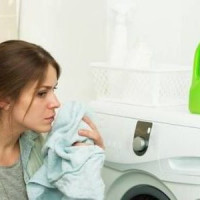 Unpleasant odor in the washing machine: causes of odor and methods for eliminating it
Unpleasant odor in the washing machine: causes of odor and methods for eliminating it 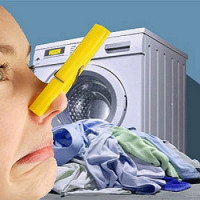 How to get rid of mold in the washing machine with improvised means at home
How to get rid of mold in the washing machine with improvised means at home  Pump for a washing machine: how to choose + how to replace
Pump for a washing machine: how to choose + how to replace 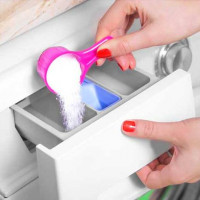 Where to put powder in the washing machine and how much powder to pour: balance of efficiency and economy
Where to put powder in the washing machine and how much powder to pour: balance of efficiency and economy 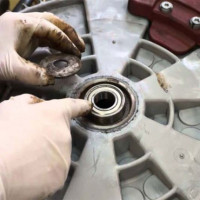 How to exchange bearings on an Indesit washing machine: step-by-step instruction
How to exchange bearings on an Indesit washing machine: step-by-step instruction 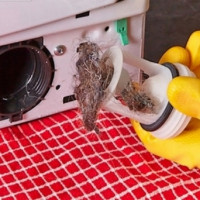 How to clean a filter in a washing machine: an overview of best practices
How to clean a filter in a washing machine: an overview of best practices  How much does it cost to connect gas to a private house: the price of organizing gas supply
How much does it cost to connect gas to a private house: the price of organizing gas supply  The best washing machines with dryer: model rating and customer tips
The best washing machines with dryer: model rating and customer tips  What is the color temperature of light and the nuances of choosing the temperature of the lamps to suit your needs
What is the color temperature of light and the nuances of choosing the temperature of the lamps to suit your needs  Replacement of a geyser in an apartment: replacement paperwork + basic norms and requirements
Replacement of a geyser in an apartment: replacement paperwork + basic norms and requirements
Periodically clean the washing machine with citric acid. I divorce her, put it in the powder compartment and turn on the program, but I don’t load the laundry. A lot of information has appeared on the Internet how to bleach clothes using acetylsalicylic acid. I am a medic, often wash white coats. I tried adding 10 crushed tablets of this acetyl powder to the powder when washing them. The result pleased. Dressing gowns are snow-white. I think that this is also useful for the machine: acetylsalicylic acid helps to soften water and remove scale.
Soda is better than citric acid. The citric acid sachets are now not what they used to be. It is not even sour, but some nasty, completely incomprehensible. So, there will be no sense from her. I boiled a kettle with her - no use. And about acetylsalicylic acid should be wound around the mustache, I'll try. And not only wash the machine, but also wash the laundry with it, since such a thing.
Is there any effective chemistry that would definitely help? I tried aspirin and citric acid, but almost no result. And the second question - is it difficult to clean the machine manually?
Hello. Manually - this is with the disassembly of the tank? Such work is best done by specialists. To prevent and reduce the risk of pollution, it is worthwhile to make some efforts.
In general, what causes the pollution of the washing machine? This is the deposition of salts and minerals from water, which is solved by installing filters, as well as using specialized descaling agents for each wash, for example, the sensational once “calgon”. Of course, not everyone can afford it, you can use them for cleaning periodically, since there are many tools for universal use, during washing and for blank cleaning. FILTERO 601 is praised very much, its price is about 150 rubles per package. Of the minuses - uneconomical consumption of funds. TOP HOUSE liquid, 37 applications for 450 rubles. In addition, Magic Power, Topper, Antinakipin, Bork (4 cleanings for 990 rubles, not the best offer), Luxus Professional are popular.
For the prevention of plaque, use powders with phosphonates (phosphates can also be used, but they are harmful to humans). True, with an already formed raid, they will not help, but they will prevent its appearance very well.Heavily soiled items are recommended to be soaked before washing and rinsing before washing.
Folk remedies for cleaning are all the same acids, because magnesium-calcium salt (scale), they dissolve best. Choose any of the options:
1. Lemon 4-6 sachets at maximum temperature.
2. 1/4 cup of soda, 2 cups of vinegar, 1/4 cup of water - mix the soda with water, and pour the vinegar into the drum and turn on at maximum speed.
If nothing helps, it's easier to invite a specialist.
Every time after washing, be sure to clean the sealing gum and clean the drain hole more often.